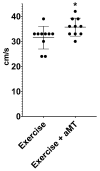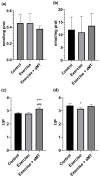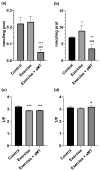Effects of Melatonin Administration on Physical Performance and Biochemical Responses Following Exhaustive Treadmill Exercise
- PMID: 39727943
- PMCID: PMC11726755
- DOI: 10.3390/cimb46120815
Effects of Melatonin Administration on Physical Performance and Biochemical Responses Following Exhaustive Treadmill Exercise
Abstract
Exercise, despite being a beneficial activity for health, can also be a source of oxidative imbalance, which can lead to a decrease in performance. Furthermore, melatonin is an endogenous molecule that may counteract exercise-induced oxidative stress. The aim of this study was to evaluate the potential ergogenic and antioxidant capacity of melatonin administered for a maximal effort test. A total of 30 rats were divided into three groups-control, exercise, and exercise + melatonin (intraperitoneal administration of 10 mg/kg)-to assess the effects of an exhaustive incremental protocol in the two exercise groups (with and without melatonin) on the treadmill-running performance (final speed reached), lipid and protein oxidation markers (malondialdehyde + 4-hidroxyalkenals and carbonyl content, respectively), and cellular and mitochondrial membranes' fluidity in skeletal muscle, brain, and liver tissues. Our results show an ergogenic effect of melatonin (31 ± 4 vs. 36 ± 4 cm/s), which may be due to its antioxidant properties being significantly stronger than its protective effect when performing increasing exercise on a treadmill until exhaustion. Melatonin reverted the membrane rigidity in the brain caused by exercise (with no effect on muscle or liver), prevented lipid oxidation in muscle, and prevented lipid and protein oxidation in the liver. Differences between tissues' responses to exercise and melatonin need to be investigated in the future to elucidate other possible mechanisms that explain melatonin's ergogenic effect.
Keywords: brain; ergogenic; lipid peroxidation; liver; membrane fluidity; muscle; protein oxidation; tissue biomarkers.
Conflict of interest statement
The authors declare no conflicts of interest. The funders had no role in the design of the study; in the collection, analyses, or interpretation of data; in the writing of the manuscript; or in the decision to publish the results.
Figures






Similar articles
-
Effects of melatonin ingestion on physical performance and biochemical responses following exhaustive running exercise in soccer players.Biol Sport. 2022 Mar;39(2):473-479. doi: 10.5114/biolsport.2022.106385. Epub 2021 Jul 2. Biol Sport. 2022. PMID: 35309526 Free PMC article.
-
Melatonin Has An Ergogenic Effect But Does Not Prevent Inflammation and Damage In Exhaustive Exercise.Sci Rep. 2015 Dec 16;5:18065. doi: 10.1038/srep18065. Sci Rep. 2015. PMID: 26669455 Free PMC article.
-
Effects of melatonin on low-dose lipopolysaccharide-induced oxidative stress in mouse liver, muscle, and kidney.Can J Physiol Pharmacol. 2018 Nov;96(11):1153-1160. doi: 10.1139/cjpp-2018-0011. Epub 2018 Aug 7. Can J Physiol Pharmacol. 2018. PMID: 30086243
-
Protective effects of melatonin in reducing oxidative stress and in preserving the fluidity of biological membranes: a review.J Pineal Res. 2014 Apr;56(3):225-37. doi: 10.1111/jpi.12128. Epub 2014 Mar 7. J Pineal Res. 2014. PMID: 24571249 Review.
-
Melatonin in relation to cellular antioxidative defense mechanisms.Horm Metab Res. 1997 Aug;29(8):363-72. doi: 10.1055/s-2007-979057. Horm Metab Res. 1997. PMID: 9288572 Review.
Cited by
-
From Mind to Milk: The Influence of Psychological Factors on the Composition of Human Breast Milk.Nutrients. 2025 Mar 20;17(6):1093. doi: 10.3390/nu17061093. Nutrients. 2025. PMID: 40292567 Free PMC article.
References
-
- Hirschfield W., Moody M.R., O’Brien W.E., Gregg A.R., Bryan R.M., Jr., Reid M.B. Nitric Oxide Release and Contractile Properties of Skeletal Muscles from Mice Deficient in Type III NOS. Am. J. Physiol. Regul. Integr. Comp. Physiol. 2000;278:R95–R100. doi: 10.1152/ajpregu.2000.278.1.R95. - DOI - PubMed
Grants and funding
LinkOut - more resources
Full Text Sources

